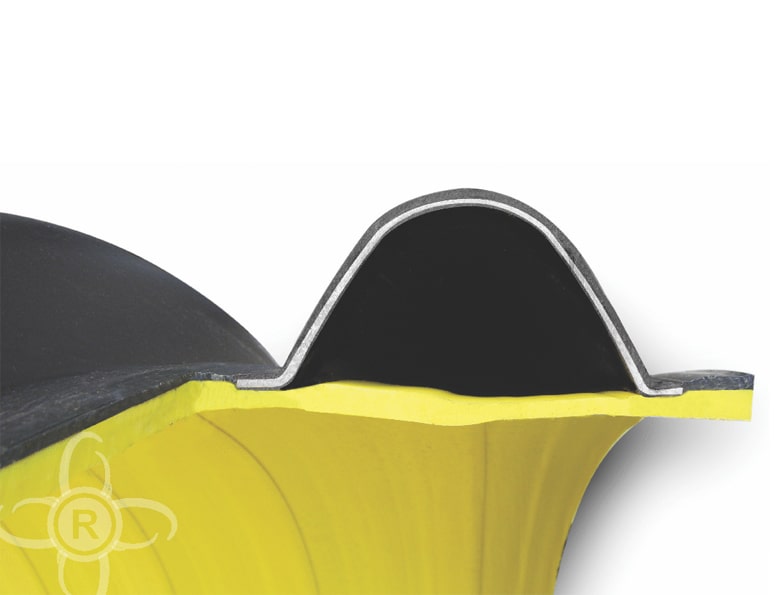High-Pressure Corrugated Pipes
High-pressure corrugated pipes are a type of double-walled plastic pipe specifically designed for use in sewage, drainage, channeling systems, and water and wastewater infrastructure. Due to their unique structure, which includes a corrugated outer wall and a smooth inner wall, these pipes offer high strength and resistance to pressure.
Features and Benefits of High-Pressure Corrugated Pipes:
- High Pressure Resistance: These pipes are designed to withstand high pressure in underground systems.
- Lightweight: Compared to metal or concrete pipes, they are lighter and easier to install.
- Resistance to Corrosion and Chemicals: Due to their polyethylene composition, they are highly resistant to chemicals and acids.
- Long Lifespan: These pipes typically last more than 50 years.
- Proper Sealing: Special fittings prevent leakage of water or wastewater.
- High Flexibility: They are resistant to ground shifts and settlement.
Applications of High-Pressure Corrugated Pipes:
- Urban and industrial wastewater transmission
- Drainage systems and surface water collection
- Water supply channels
- Underground tunnels and hydraulic structures
Pressure Class Types:
Corrugated pipes are divided into different pressure classes based on their ability to withstand pressure (e.g., SN4 or SN8), with the number indicating the pipe’s resistance to circumferential pressure. The type of pipe selected depends on the project’s requirements and environmental conditions.
Manufacturing Methods for High-Pressure Corrugated Pipes:
Corrugated pipes are manufactured using an extrusion process. In this process, the raw material (polyethylene) is melted and shaped into the inner and outer walls using specialized molds.
Production Steps:
- Melting and Extrusion of Raw Materials: High-quality polyethylene is melted at a specific temperature and passed through an extruder.
- Shaping of Walls: The inner wall of the pipe is smooth, while the outer wall is corrugated to provide greater mechanical strength.
- Cooling: After exiting the mold, the pipe is cooled through cooling systems to solidify.
- Cutting to Standard Lengths: The pipes are cut to standard lengths (usually 6 or 12 meters) according to project requirements.
- Quality Control: All pipes are checked for dimensions, pressure resistance, chemical resistance, and other technical specifications.
Standards for High-Pressure Corrugated Pipes:
These pipes are typically manufactured in accordance with international standards such as EN 13476, DIN 16961, and Iranian national standards. Adhering to these standards ensures product quality and durability.
Key Parameters in Standards:
- Pipe Diameter: Ranges from 110 mm to over 3000 mm
- Pressure Class: Determines the pipe’s circumferential pressure resistance (e.g., SN4, SN8, and higher)
- Raw Materials: High-density polyethylene (HDPE) or sometimes polypropylene (PP)
Corrugated Pipe Fittings:
Corrugated pipes are connected using special fittings such as couplers and rubber seals. These fittings ensure complete water-tightness and prevent fluid leakage. In some projects, thermal welding or electrofusion is also used for connections.
Types of Fittings:
- Couplers: Used to connect two pipes together
- Rubber Seals: Used to create a complete seal
- Elbows and Tees: Used to change direction or branch off
- End Caps and Access Ports: Used for sealing or access to the interior of the pipe
Installation of High-Pressure Corrugated Pipes:
The installation of corrugated pipes should be done following engineering principles and with the proper equipment. The process includes the following steps:
- Preparing the Foundation: The base should be smooth and compacted to prevent pipe settlement.
- Placing the Pipe: Pipes should be carefully positioned in place.
- Connecting the Pipes: Pipes are connected using the appropriate fittings.
- Backfilling Around the Pipe: Suitable materials such as sand or gravel are used to backfill around and above the pipe.
- Final Testing: The installed system is tested for leaks or other issues.
Important Considerations for Selection and Use:
- Choosing the Right Diameter: Based on the fluid volume and project conditions
- Considering the Pressure Class: The pipe should be able to withstand the environmental pressure and fluid flow
- Environmental Conditions: Consider the temperature and possible exposure to chemicals in the area
- Brand and Manufacturer: Using standardized products from reputable brands ensures the quality and durability of the project.
Our company, as the sole manufacturer of 2400 mm double-wall spiral reinforced corrugated pipes, is ready to provide manufacturing, export, delivery, and after-sales services to all customers across the Middle East. Please contact us if you need further information.

